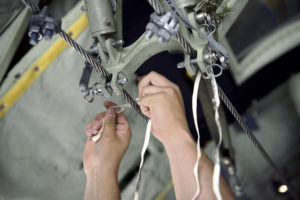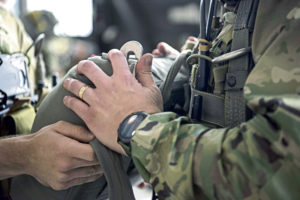
To provide the world’s greatest tactical airlift expertise anytime, anywhere, to the United States, our allies and to those in need: such is the mission of the 37th Airlift Squadron.
“The 37th has been really busy over the summer,” said Lt. Col. Beau Tresemer, 37th AS director of operations. “COVID-19 isn’t stopping and neither are we.”
Airlift is more than just picking up cargo and dropping it off somewhere. Similar to an aircraft, an entire system is in place for the 37th AS, and it connects with other systems in different squadrons to make their missions possible.
According to Staff Sgt. Brian Clark, 37th AS loadmaster, the process from notification to liftoff can move extremely quickly.
“If we’re going to fly a humanitarian mission, we’ll get a message from our aircraft commander — an alert message letting us know that we are, indeed, going to do the mission,” Clark said. “Once we get that message, we have an hour to show up at the squadron.”

Although everyone who was notified for the mission must act quickly, it’s also important for them to note their physical and mental status. Risk management protocols are in place to certify that Airmen are capable of accomplishing the mission for that day.
Communication is key to maintaining a clear vision of what’s happening. After those first steps are taken, the 37th AS will link up with other squadrons, such as the 86th Logistics Readiness Squadron, under which the Air Terminal Operations Center falls.
“I’ll check in with the ATOC and actually see what cargo we have for this humanitarian mission,” Clark said. “I’ll also call the passenger terminal to see if we have any passengers who are going on the mission. Once that happens, I’ll get my pro gear–things I’m going to need to actually go out and fly with. I’ll get a tool kit, reading material, and we’ll go and catch our crew bus to the flight line.”
When they arrive, crew members go to their designated aircraft and begin their pre-flight duties, said Clark.
“We put power to the aircraft and verify the cargo department is configured in such a way that we’re able to accomplish the mission.”
Shortly after, ATOC personnel will arrive with the verified cargo. Then, passengers will show up and the pilots will come out to take care of their pre-flight duties.

“At that point, once we have everything on the plane, safely put into the box, strapped down, we’ll fly our mission to wherever we’re going, unload everything, turn around and come back,” said Clark.
Loading pallets and dropping them off is only the tip of the iceberg. Beneath the surface is an entire organization of dedicated individuals working together to ensure the safe delivery of cargo and personnel.
“It takes the whole team,” said Tresemer. “It’s not just us landing somewhere, dropping stuff off and leaving. There’s a huge logistics and support tail that helps us to get out the door, as well as receive us when we’re on the ground. A lot of the time, we’re the face of that, but we couldn’t make any of that happen without everyone here on Team Ramstein.”
The commitments of the 37th AS, as well as the 86th LRS, are a great part of what keeps the “lift” in the 86th Airlift Wing.


